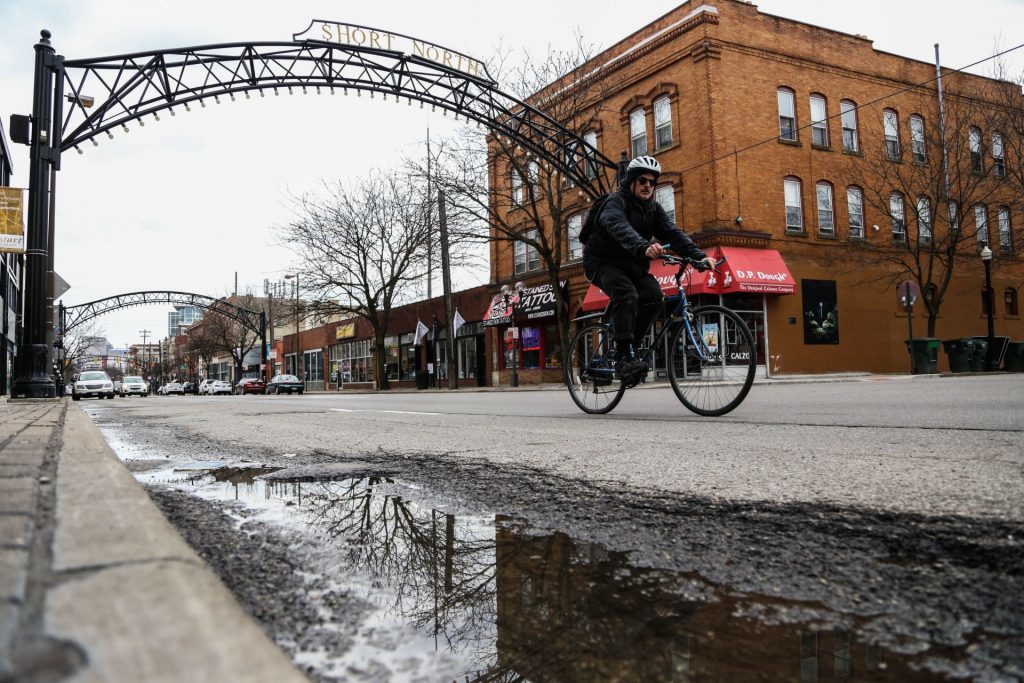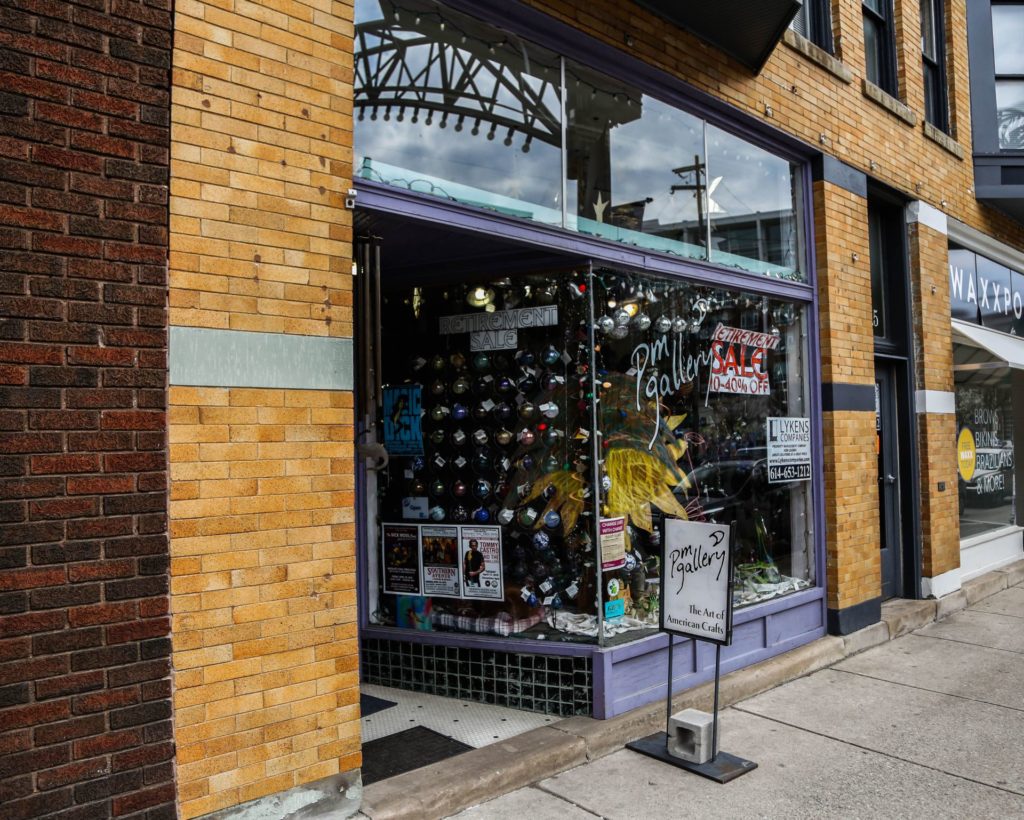Short North Development Leaves Galleries Behind
By Shanti Lerner and Kaylee Harter

Twenty-year-old Maria Galloway had an epiphany: she wanted to open an art gallery. She was walking her dog in Tuttle Park when she met a man who owned a building on High Street. It was a hole-in-the-wall and the neighborhood was scary, derelict and seedy — mostly consisting of strip clubs and dive bars — but Galloway decided to take a chance. After six months of hard work fixing up the space, she and her husband Michael Galloway opened PM Gallery in 1980.
Now located at 5th Avenue and High Street, PM Gallery will be closing its doors this summer.
For the last 38 years, Galloway has watched the Short North transform through her gallery window. Today, restaurants, trendy bars, specialty beauty salons and luxury apartments call the Short North home. With a population that is expected to grow significantly in coming years and no measures currently in place to preserve the area’s character, the neighborhood could be at risk of losing the art galleries and small businesses that drove its transformation.
“Artists love cheap rent,” Galloway said. “And there was critical mass here. Enough of an infrastructure, there was lots of buildings and they were close together. So there was lots of spaces that were close together and you could have an event like the gallery hop.”
Beginning in 1984, Gallery Hop, a monthly event where Short North galleries open to showcase their latest artwork, encouraged people to visit the neighborhood. Pioneered by the first few galleries, Gallery Hop eventually made the Short North a local destination of choice.
“Gallery Hop is what changed everything,” Galloway said. “It was phenomenal. We had no idea how much it was going to change everything. It was that safety factor. If you could come down here at night and not get killed, it was a big deal. Then you could come down during the day. You got familiar with the neighborhood. It was safety in numbers.”
Not only were shifts happening in commercial spaces, they also were happening in the residential areas of the neighborhood. Maria Conroy, member of the city of Columbus’ Development Commission, said more people started buying old, historic houses in Victorian Village –– many of which had been neglected and run down. The sudden influx of new residents resulted in a need for more amenities to accommodate them.
“There was a demographic shift, people started seeing some value in buying up in Victorian Village,” said Conroy, who also is an associate professor and graduate studies chair in city and regional planning at Ohio State. “There was more attention to services for these new residents who had some more disposable income.”
In this period of rapid change, the city began putting money back into the neighborhood. Over time, there was a conscious effort to invest in humanizing the landscape, including the reinstallation of the now-famous seven steel arches and street trees.
“We had no idea how much it was going to change everything.”
As Galloway watched the neighborhood evolve, one of the most disconcerting changes in the neighborhood were the types of businesses that now called the area home. She slowly watched more and more restaurants move into the area, often taking over spaces that once housed galleries.
That was the turning point. Galloway said the influx of restaurants signified that the Short North was becoming more attractive for other types of businesses and gave landlords the ability to increase their rents, making it more difficult for small businesses to afford to stay.
In an analysis of property values in the Short North between 1999 and 2017, real estate prices have more than doubled in various parts of the neighborhood.
Across the street from PM Gallery’s old location –– what used to house Two Fish Bistro, a restaurant that took the place of four gallery spaces –– the property values have risen from $1.1 million in 1999 to $2 million in 2017. Today, Forno Kitchen + Bar occupies the space.
According to the Short North Alliance’s annual report in 2016, 15 galleries were open in the Short North. Now, only 12 are listed, and two more –– PM Gallery and Roy G Biv Gallery –– are set to close this summer.
“The area, its land prices and housing prices are a function of demand,” Conroy said. “People want to be down here and that means that [land owners] can ask for higher prices.”
And that demand apparently won’t stop rising any time soon. With the central Ohio population projected to increase by 1 million people by 2050, according to a report by the Mid-Ohio Regional Planning Commission, new developments are popping up all over the city.
“With the Short North being a place with a lot of the characteristics that are desirable for people –– like walkability and lots of things close by to do and it’s an amazing community –– it is sort of one of those places that’s really started to see and experience a lot of the construction and development type things first,” said Betsy Pandora, executive director of the Short North Alliance.
For some residents, like Galloway, the increase in population density that’s been encouraged by new developments and old tax abatements has brought some unwelcome consequences.

Despite all this, Rachel Kleit, head of the city and regional planning section at the Knowlton School of Architecture, said increasing density is generally a good thing.
“With the number of people, the way their neighborhood feels is changing, and that’s hard,” she said. “The pace of change has picked up, but these are good things generally speaking in terms of the life of a neighborhood.”
Density leads to vitality and allows for a place where people can live, work and shop without needing a car. It’s part of why the Short North attracts young professionals.
The effort to create a condensed and walkable place has led to a push for mixed-use buildings that serve multiple purposes within the same property. Oftentimes, these spaces are used for commercial or office spaces on the first and second stories with residential spaces above. Currently, seven mixed-use buildings are under construction in the Short North, according to Columbus Underground.
“The growth is inevitable,” Kleit said. “The question is: how do you shape the growth?”
Shaping the vision and growth of a city can be complicated in a world where the free market rules. Conroy said that although the city’s commissions have a measure of control over the kinds of developments that occur, they don’t necessarily set a limit on the types of businesses that want to set up shop in the Short North.
“We need a community-centered vision for what we want to be. It’s not saying things have to stay the same –– sometimes change is a good thing –– but it should be done with the support and the cohesive vision of the community,” Conroy said. “Without having that plan, we just react, we are just reacting to rezoning requests, instead of saying this is what we want to be and we are going to support those endeavours that are in line with our vision.”
With decisions in the hands of landowners, it might be important for galleries and small businesses to gain control of properties.
Kleit said this could perhaps be done through subsidies or through a cooperative of galleries that seek to purchase the spaces together, provided that the land owners are willing to sell.
“If the prices of the commercial spaces are increasing to the extent that they are forcing galleries out –– and that it’s not a matter of retirement –– then likely there should be something that’s done and that requires some investment and also a lot of organizing,” she said.
“Be creative. Don’t go the easy route. Make an effort.”
Aside from the rising prices of commercial spaces, the rising cost of residential spaces is making it difficult to maintain economic diversity.
Because of this, Galloway said she fears “cool people” won’t be able to live in the neighborhood anymore.
For Kleit, the economic diversity — which is vital in keeping a neighborhood alive — could very well be lost. If none of the people working in the neighborhood can afford to live there, then the walkability that developers worked so hard to create would diminish.
As PM Gallery nears its close, Maria Galloway will not be around to see how it all ends.
But Galloway’s art days are far from over. The Galloways will be moving to rural Florida and will be bringing a little piece of the Short North along with them.
“We’re going to have our studios and open up one Saturday a month for old-times sake,” Galloway said. “Open up the front porch for people to come through and see what we’re doing.”
Before she leaves, however, Galloway has some parting words for developers in the Short North.
“Be creative. Don’t go the easy route. Make an effort,” she said. “I’m seeing a lot of lowest common denominator and I wanna see innovation. I wanna see a little sweat and tears on their part, not just reaping what we sowed.”